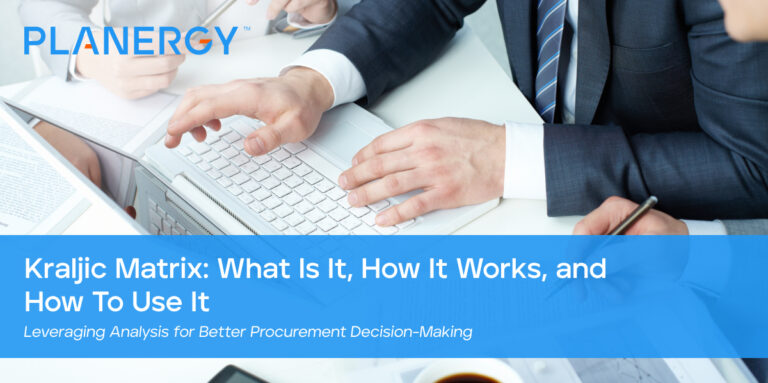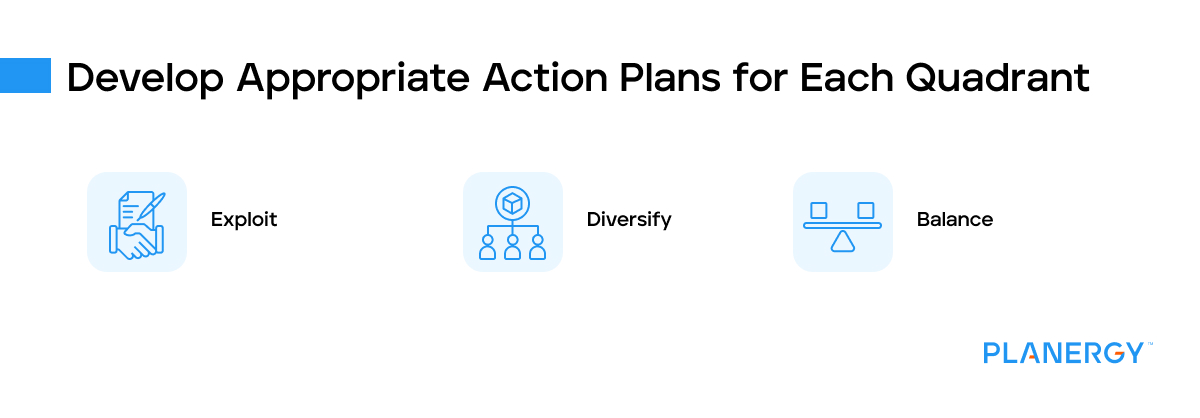The Kraljic Matrix, or Kralijic Model, is a strategic tool procurement and supply chain professionals use to identify and minimize risks in supply management.
By segmenting suppliers based on their importance and level of risk it can help to identify and minimize supply chain risks and risks related to vendor management.
Named after its creator, Peter Kraljic, this method revolutionized the procurement industry when it was introduced in 1983 and is still used widely today.
Who is Peter Kraljic?
Peter Kraljic is an economist. Until July 2002 he was a senior Director at McKinsey.
Peter developed the model and published it in a 1983 article in the Harvard Business Review called “Purchasing Must Become Supply Management.”
He developed the model after recognizing the need for a more strategic approach to procurement and supply chain management.
With his approach, companies could better understand their supply chains and make more informed purchasing decisions.
Managing Risk and Profitability
Risk is the likelihood of something unexpected happening in the supply chain that disrupts operations.
If you have a business that makes wooden furniture, an important area of spending is lumber suppliers. If a disruption happens with one of your key wood suppliers then your company could be at risk of serious issues with meeting demand for your products.
Risks depend on various factors, including geographic location, supply chain length, and business model. Vendors based in developed countries, logistical delays and political uncertainty are less likely to cause operations issues.
But, if your vendor’s facilities are based in a developing country, the risk of legislative changes, political unrest, and even transportation routes can affect you as a buyer.
Profitability, on the other hand, refers to the effect a supply item has on the company’s bottom line. Certain areas of spend, such as business cards and letterhead, have a negligible effect on profit.
However, in other categories, a single source of supply has the potential to make or break your business.
For instance, tech giant Apple, has a strong dependence for its profits on whether or not it’s key electronics manufacturing supplier, Foxconn, can manufacture the scale of products to their specification.
The Quadrants of the Kraljic Matrix
The Kraljic Matrix is divided into four quadrants, or purchase categories, each representing different types of purchases or suppliers based on supply risk and profit contribution.
Supply risk will run from low to high on the horizontal axis. Profit impact will run from low to high on the vertical axis.
On the bottom left, where there is a low supply risk and low profit impact, you’ll have your non-critical items.
On the bottom right, where there is a high supply risk, but low profit impact, you’ll have your bottleneck items.
On the top left, where there is high profit impact, but supply risk is low, you’ll have your leverage items.
On the top right, where both profit impact and supply risk are high, you’ll have your strategic items.
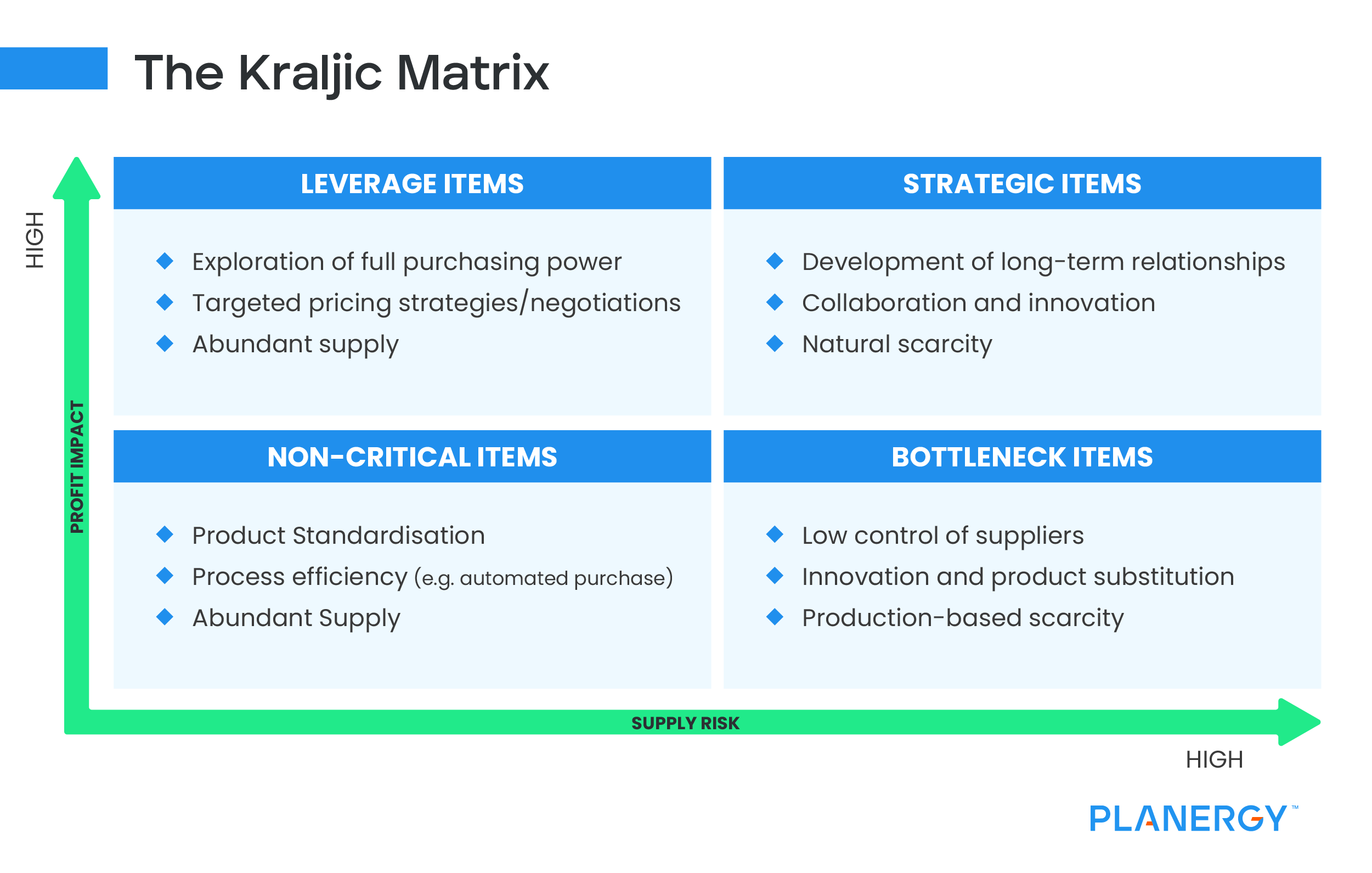
Strategic Items
These are items that are both high supply risk and high-profit contribution. They are crucial to your organization’s success and require careful supplier risk management.
You can only get these items from a small number of suppliers, or ones for which there are no acceptable substitutes. That’s why you need a predictable and effective supplier relationship.
To manage suppliers in this quadrant, spend time building and improving the relationship. These companies aren’t just vendors; they’re partners in your business and should be treated as such.
Bottleneck Items
These items are high supply risk and low profit impact. While these items don’t significantly contribute to profitability, their supply risk makes them important to manage.
Here, the supplier has the upper hand. Prices can quickly rise since the market often consists of a few suppliers. Many procurement professionals have found that it costs more of the buyer’s time than other quadrants.
Even though these items don’t really affect your profitability much, the market forces you to accept deals you otherwise would not.
The best strategy here is to limit the damage. You must recognize that you won’t get many opportunities in this area and ensure you maintain good relationships with the suppliers you have available.
Leverage Items
These are the sweet spot because they are low-supply risk but high-profit impact. This is where you will find your greatest opportunities to realize cost savings.
As a buyer, you have the balance of power in the relationship, so you can leverage this strength to generate more profit.
When it comes to these items, negotiate. Switching suppliers to achieve the best price is always possible but do so carefully. It’s easy to abuse the status.
Non-Critical Items
These are both low-supply risk and low-profit contributions. These routine purchases, often falling into the classification of tail spend, require efficient processing. The easiest example to explore here is office supplies.
Yes, your employees need these to do their job, but the pens and paper you use don’t significantly impact your business – and going without them doesn’t pose a serious threat to operations.
However, these items are worth paying attention to because the cost of handling them can easily be more expensive than the supplies
themselves. That’s why it’s crucial to use purchasing strategies focused on reducing administrative costs and logistical complexity.You can do this by delegating the authority to order office supplies to each department that requires it. This way, you’re reducing the administrative burden on the purchasing department but avoiding additional overhead costs on all the others.
Dedicated procure-to-pay software, like PLANERGY, can greatly improve efficiency in these areas of spend.
The Kraljic Matric groups risk with profitability gives you a 2×2 matrix to better segment your suppliers based on how they impact your business.
How to Use the Kraljic Matrix for Procurement Optimization
The Kraljic Matrix helps organizations prioritize their purchasing efforts, improve supplier relations, and reduce supply chain risks.
By classifying purchases or suppliers into the four quadrants, companies can develop tailored strategies for each category.
More strategic procurement efforts will result in better outcomes for the business.
For example, strategic items may require long-term contracts and strong supplier relationships, while leverage items might be best sourced through competitive bidding.
Meanwhile, bottleneck items could benefit from safety stocks or alternative suppliers, and non-critical items can be managed through efficient ordering processes.
With it, you can choose the most appropriate purchasing strategy for each product, service, etc., your business uses and then adapt it accordingly to minimize risk.
It also helps you determine which products you should focus your attention on, the supplier relationships you should nurture, and the ones you should consider cutting from the budget.
The Step-by-Step Process of Using the Kraljic Matrix
To use the Kraljic Matrix effectively you should follow these steps.
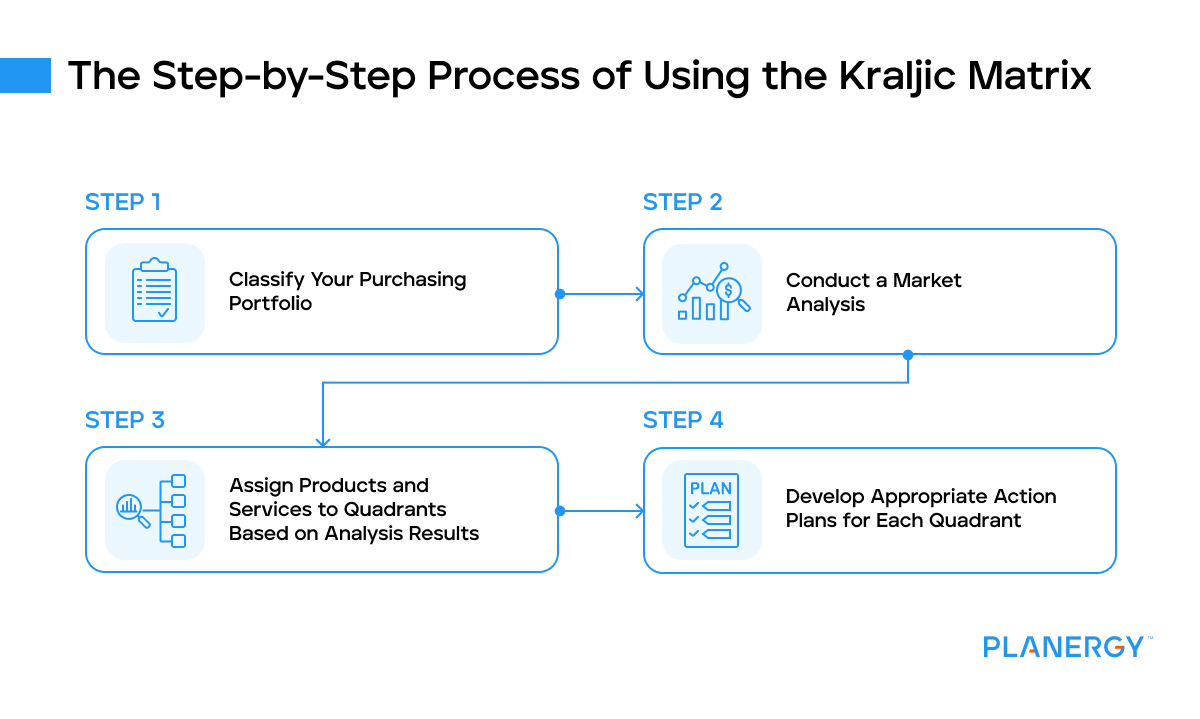
Classify Your Purchasing Portfolio
List and classify everything you purchase for your business operations. Include services, products, components, and commodities.
If you do not have good spend visibility across your company this might prove to be a bigger challenge thank it initially sounds like.
Then, start to categorize them based on the level of supply risk and the profit impact of each item in your portfolio.Your supply risk is high when availability can be influenced by things such as:
- Government restrictions
- Scarcity of raw materials
- Supply chain disruption
- Natural disasters
- The low number of available suppliers to choose from
Conduct a Market Analysis
Next, conduct a comprehensive market analysis. This involves understanding the dynamics of your market and the specific supply risks associated with each product or service you purchase.
Market intelligence for your key procurement areas and trend analysis of your procurement can be useful in this process.
Supply risk can be assessed based on factors such as supplier reliability, availability of alternative suppliers, and potential for supply disruption.
On the other hand, profit contribution can be gauged by considering factors like the item’s impact on product quality, its contribution to sales revenue, and how much it influences customer satisfaction.
Assign Products and Services to Quadrants Based on Analysis Results
Once you have assessed each item’s supply risk and profit contribution, assign each product or service to the graph where they will fall within a quadrant of the Kraljic Matrix. This process is known as strategic positioning.
Strategic items with high supply risk and high-profit contribution are placed in the top right quadrant.
Bottleneck items with high supply risk but low-profit contribution go in the top left quadrant.
Leverage items, with low supply risk but high-profit contribution, are positioned in the bottom right quadrant.
Lastly, non-critical items, with low supply risk and low-profit contribution, belong in the bottom left quadrant.
Develop Appropriate Action Plans for Each Quadrant
After categorizing the items, the final step is to develop procurement strategies tailored to each quadrant.
For strategic items, consider forming close relationships with suppliers, investing in joint developments, or even securing secondary sources to mitigate risk.
Look at simplifying specifications, seeking new suppliers, or creating contingency plans for bottleneck items.
Procurement teams should exploit their buying power when dealing with leverage items to negotiate better terms or prices.
For non-critical items, the focus should be on process efficiency, such as automated ordering and invoicing.
Under the Krajlic model, there are three possible options:
Exploit
Here’s where you choose to maximize your buying power. You seek to secure the best possible deals and develop strong, long-term relationships with multiple suppliers to reduce your risk with the corresponding items.
Diversify
In this instance, you find alternative suppliers or products to reduce your overall risk.
Balance
Here, you try to find a balance between exploiting and diversifying so you can secure supply security.

Remember, the Kraljic Matrix is not a one-time exercise. Regular review and adjustment of categories and strategies are necessary to reflect the dynamic nature of markets.
Challenges of the Kraljic Matrix
This approach is well-known in procurement, but it’s not without flaws.
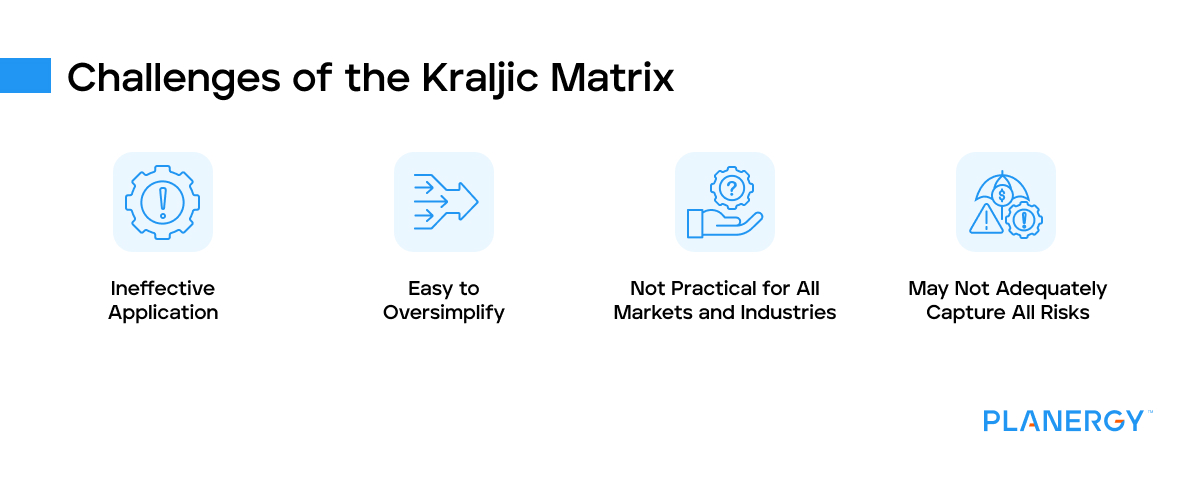
Ineffective Application
The model works but is ineffective if it’s not applied correctly.
You may believe your suppliers are strategic, but if they’re not and are miscategorized, it could throw off your entire procurement strategy.
You create resource-intensive and expensive relationships that don’t affect profitability much. You may focus on the wrong suppliers to avoid financial risk in your supply chain.
At the same time, if you treat your strategic suppliers as non-critical, you could easily lose a lot of profit. Over time, this will impact your business’s viability.
Easy to Oversimplify
The reality is this kind of analysis can oversimplify your procurement activities. By focussing on just 2 key dimensions there may be nuance lacking in your assessments.
Other relevant factors may not be adequately considered. Factors like product quality, innovation, or delivery time.
Not Practical for All Markets and Industries
It may not be possible to leverage this model in rapidly evolving markets. While you shouldn’t treat it as a one-and-done exercise anyway, in a market that changes too fast, you may need to repeat it too often to generate any real insight for your business.
May Not Adequately Capture All Risks
While it’s a good start, it may not be able to demonstrate all the possible risks with a purchase.
This means you won’t fully understand your company’s procurement activities. It doesn’t consider factors like natural disasters, political instability, or regulation changes that may influence your supply chain.
Because it only focuses on two dimensions, it will not provide a comprehensive view of all your procurement activities, such as supplier performance, supplier relationships, and contract management.
Final Thoughts
For true strategic purchasing, you should use the Kraljic Matrix as one tool in your overall analysis since it lacks active dynamics.
It should be used with other procurement management and risk analysis tools for supplier risk management and tailored to your business’s specific needs to get the best results.
In procurement, the core of all your actions should be focused on leveraging products to keep shareholders happy, keeping costs low to increase profit.
With routine products, you can increase product by reducing the handling associated with purchasing.
Beyond delegating it to department heads, you can rely on e-procurement tools to help you do the job faster with fewer hands in the pie.

